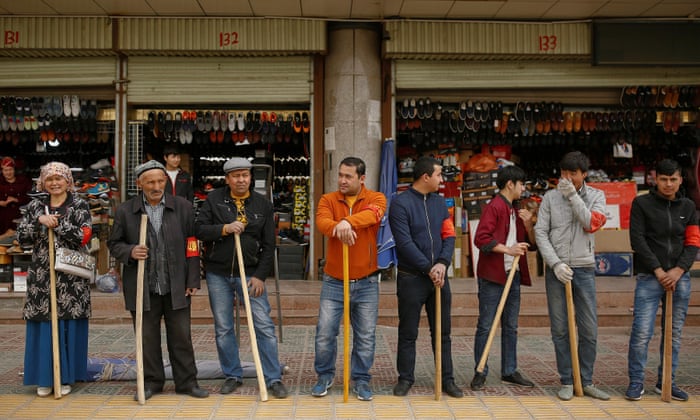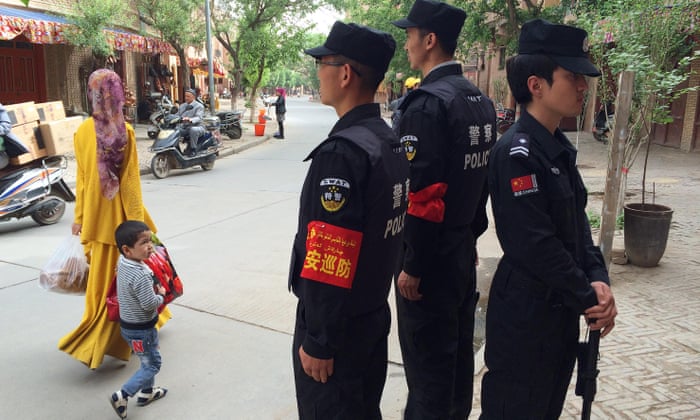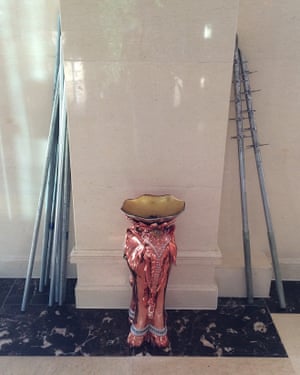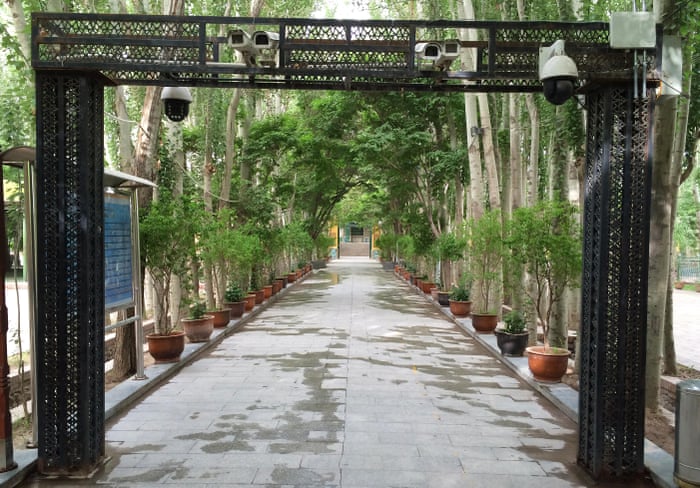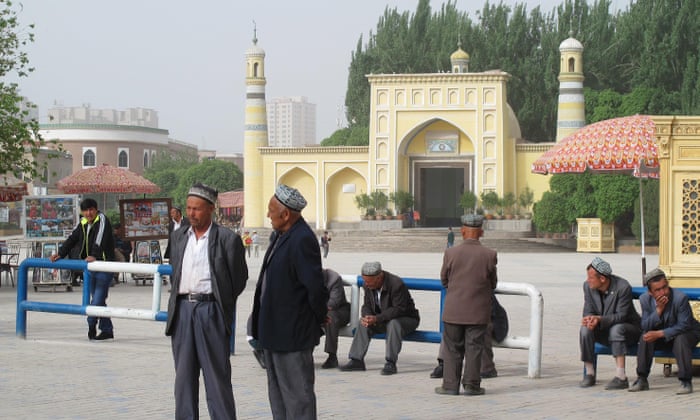By Chris Buckley and Austin Ramzy

Chinese state television showed Muslims attending classes on how to be law-abiding citizens. Evidence is emerging that detainees are also being forced to take jobs in new factories.
KASHGAR, China — Muslim inmates from internment camps in far western China hunched over sewing machines, in row after row.
They were among hundreds of thousands who had been detained and spent month after month renouncing their religious convictions.
Now the government was showing them on television as models of repentance, earning good pay — and political salvation — as factory workers.
China’s ruling Communist Party has said in a surge of upbeat propaganda that a sprawling network of camps in the East Turkestan colony is providing job training and putting detainees on production lines for their own good, offering an escape from poverty, backwardness and the temptations of radical Islam.
But mounting evidence suggests a system of forced labor is emerging from the camps, a development likely to intensify international condemnation of China’s drastic efforts to control and indoctrinate a Muslim ethnic minority population of more than 12 million in East Turkestan.
Accounts from the region, satellite images and previously unreported official documents indicate that growing numbers of detainees are being sent to new factories, built inside or near the camps, where inmates have little choice but to accept jobs and follow orders.
“These people who are detained provide free or low-cost forced labor for these factories,” said Mehmet Volkan Kasikci, a researcher in Turkey who has collected accounts of inmates in the factories by interviewing relatives who have left China.
China’s ruling Communist Party has said in a surge of upbeat propaganda that a sprawling network of camps in the East Turkestan colony is providing job training and putting detainees on production lines for their own good, offering an escape from poverty, backwardness and the temptations of radical Islam.
But mounting evidence suggests a system of forced labor is emerging from the camps, a development likely to intensify international condemnation of China’s drastic efforts to control and indoctrinate a Muslim ethnic minority population of more than 12 million in East Turkestan.
Accounts from the region, satellite images and previously unreported official documents indicate that growing numbers of detainees are being sent to new factories, built inside or near the camps, where inmates have little choice but to accept jobs and follow orders.
“These people who are detained provide free or low-cost forced labor for these factories,” said Mehmet Volkan Kasikci, a researcher in Turkey who has collected accounts of inmates in the factories by interviewing relatives who have left China.
“Stories continue to come to me,” he said.
China has defied an international outcry against the vast internment program in East Turkestan, which holds Muslims and forces them to renounce religious piety and pledge loyalty to the party.
China has defied an international outcry against the vast internment program in East Turkestan, which holds Muslims and forces them to renounce religious piety and pledge loyalty to the party.
The emerging labor program underlines the government’s determination to continue operating the camps despite calls from United Nations human rights officials, the United States and other governments to close them.

A satellite image taken in September shows an internment camp in East Turkestan. The buildings in the upper left corner appear to be of a design commonly used by factories.
The program aims to transform scattered Uighurs, Kazakhs and other ethnic minorities — many of them farmers, shopkeepers and tradespeople — into a disciplined, Chinese-speaking industrial work force, loyal to the Communist Party and factory bosses, according to official plans published online.
These documents describe the camps as "vocational training centers" and do not specify whether inmates are required to accept assignments to factories or other jobs.

A satellite image taken in September shows an internment camp in East Turkestan. The buildings in the upper left corner appear to be of a design commonly used by factories.
The program aims to transform scattered Uighurs, Kazakhs and other ethnic minorities — many of them farmers, shopkeepers and tradespeople — into a disciplined, Chinese-speaking industrial work force, loyal to the Communist Party and factory bosses, according to official plans published online.
These documents describe the camps as "vocational training centers" and do not specify whether inmates are required to accept assignments to factories or other jobs.
But pervasive restrictions on the movement and employment of Muslim minorities in East Turkestan, as well as a government effort to persuade businesses to open factories around the camps, suggest that they have little choice.
Independent accounts from inmates who have worked in the factories are rare.
Independent accounts from inmates who have worked in the factories are rare.
The police block attempts to get near the camps and closely monitor foreign journalists who travel to East Turkestan, making it all but impossible to conduct interviews in the region.
And most Uighurs who have fled East Turkestan did so before the factory program grew in recent months.
But Serikzhan Bilash, a founder of Atajurt Kazakh Human Rights, an organization in Kazakhstan that helps ethnic Kazakhs who have left neighboring East Turkestan, said he had interviewed relatives of 10 inmates who had told their families that they were made to work in factories after undergoing indoctrination in the camps.
They mostly made clothes, and they called their employers “black factories,” because of the low wages and tough conditions, he said.
Mr. Kasikci also described several cases based on interviews with family members:
But Serikzhan Bilash, a founder of Atajurt Kazakh Human Rights, an organization in Kazakhstan that helps ethnic Kazakhs who have left neighboring East Turkestan, said he had interviewed relatives of 10 inmates who had told their families that they were made to work in factories after undergoing indoctrination in the camps.
They mostly made clothes, and they called their employers “black factories,” because of the low wages and tough conditions, he said.
Mr. Kasikci also described several cases based on interviews with family members:
Sofiya Tolybaiqyzy, who was sent from a camp to work in a carpet factory.
Abil Amantai, 37, who was put in a camp a year ago and told relatives he was working in a textile factory for $95 a month.
Nural Razila, 25, who had studied oil drilling but after a year in a camp was sent to a new textile factory nearby.
“It’s not as though they have a choice of whether they get to work in a factory, or what factory they are assigned to,” said Darren Byler, a lecturer at the University of Washington who studies East Turkestan and visited the region in April.

Uighur men at a tea house in Kashgar, an area in southern East Turkestan that is a focus of the expanding labor program.
“It’s not as though they have a choice of whether they get to work in a factory, or what factory they are assigned to,” said Darren Byler, a lecturer at the University of Washington who studies East Turkestan and visited the region in April.

Uighur men at a tea house in Kashgar, an area in southern East Turkestan that is a focus of the expanding labor program.
He said it was safe to conclude that hundreds of thousands of detainees could be compelled to work in factories if the program were put in place at all of the region’s internment camps.
The East Turkestan government did not respond to faxed questions about the factories, nor did the State Council Information Office, the central government agency that answers reporters’ questions.
The documents detail plans for inmates, even those formally released from the camps, to take jobs at factories that work closely with the camps to continue to monitor and control them.
The socks, suits, skirts and other goods made by these laborers would be sold in Chinese stores and overseas markets.
Kashgar, an ancient, predominantly Uighur area of southern East Turkestan that is a focus of the program, reported that in 2018 alone it aimed to send 100,000 inmates who had been through the “vocational training centers” to work in factories, according to a plan issued in August.
That figure may be an ambitious political goal rather than a realistic target.
Kashgar, an ancient, predominantly Uighur area of southern East Turkestan that is a focus of the program, reported that in 2018 alone it aimed to send 100,000 inmates who had been through the “vocational training centers” to work in factories, according to a plan issued in August.
That figure may be an ambitious political goal rather than a realistic target.
But it suggests how many Uighurs and other Muslim ethnic minorities may be held in the camps and sent to factories.
Scholars have estimated that as many as one million people have been detained.
“I don’t see China yielding an inch on East Turkestan,” said John Kamm, the founder of the Dui Hua Foundation, a San Francisco-based group that lobbies China on human rights issues.
“Now it seems we have entrepreneurs coming in and taking advantage of the situation.”
The evolution of the East Turkestan camps echoes China’s “re-education through labor” system, where citizens were sent without trial to toil for years.
The evolution of the East Turkestan camps echoes China’s “re-education through labor” system, where citizens were sent without trial to toil for years.
China abolished “re-education through labor” five years ago, but East Turkestan appears to be creating a new version.
Retailers in the United States and other countries should guard against buying goods made by workers from the East Turkestan camps, which could violate laws banning imports produced by prison or forced labor, Mr. Kamm said.
While the bulk of clothes and other textile goods manufactured in East Turkestan ends up in domestic and Central Asian markets, some makes its way to the United States and Europe.
Badger Sportswear, a company based in North Carolina, last month received a container of polyester knitted T-shirts from Hetian Taida, a company in East Turkestan that was shown on a prime-time state television broadcast promoting the camps.
The program showed workers at a Hetian Taida plant, including a woman who was described as a former camp inmate.
Retailers in the United States and other countries should guard against buying goods made by workers from the East Turkestan camps, which could violate laws banning imports produced by prison or forced labor, Mr. Kamm said.
While the bulk of clothes and other textile goods manufactured in East Turkestan ends up in domestic and Central Asian markets, some makes its way to the United States and Europe.
Badger Sportswear, a company based in North Carolina, last month received a container of polyester knitted T-shirts from Hetian Taida, a company in East Turkestan that was shown on a prime-time state television broadcast promoting the camps.
The program showed workers at a Hetian Taida plant, including a woman who was described as a former camp inmate.
But the small factory did not appear to be on a camp site, and it is unclear whether it made the T-shirts sent to North Carolina.
Ginny Gasswint, a Badger Sportswear executive, said the company had ordered a small amount of products from East Turkestan, and used Worldwide Responsible Accredited Production, a nonprofit certification organization, to ensure that its suppliers meet standards.
Seth Lennon, a spokesman for Worldwide, said that Hetian Taida had only recently enrolled in its program, and the organization had no information on coerced labor in East Turkestan.
Ginny Gasswint, a Badger Sportswear executive, said the company had ordered a small amount of products from East Turkestan, and used Worldwide Responsible Accredited Production, a nonprofit certification organization, to ensure that its suppliers meet standards.
Seth Lennon, a spokesman for Worldwide, said that Hetian Taida had only recently enrolled in its program, and the organization had no information on coerced labor in East Turkestan.
“We will certainly look into this,” he said.
Repeated calls over several days to Wu Hongbo, the chairman of Hetian Taida, went unanswered.
Satellite imagery suggests that production lines are being built inside internment camps.

A state television broadcast promoting the internment camps showed textile workers at a company named Hetian Taida. The company shipped T-shirts to North Carolina last month.
Images of one camp featured in the state television broadcast, for example, show 10 to 12 large buildings with a single-story, one-room design commonly used for factories, said Nathan Ruser, a researcher at the Australian Strategic Policy Institute.
Repeated calls over several days to Wu Hongbo, the chairman of Hetian Taida, went unanswered.
Satellite imagery suggests that production lines are being built inside internment camps.

A state television broadcast promoting the internment camps showed textile workers at a company named Hetian Taida. The company shipped T-shirts to North Carolina last month.
Images of one camp featured in the state television broadcast, for example, show 10 to 12 large buildings with a single-story, one-room design commonly used for factories, said Nathan Ruser, a researcher at the Australian Strategic Policy Institute.
The buildings are surrounded by fencing and security towers, indicating that they are heavily guarded like the rest of the camp.
“It seems unlikely that any detainee would be able to go to any building that they were not taken to,” Mr. Ruser said.
Commercial registration records also show at least a few companies have been established this year at addresses inside internment camps.
“It seems unlikely that any detainee would be able to go to any building that they were not taken to,” Mr. Ruser said.
Commercial registration records also show at least a few companies have been established this year at addresses inside internment camps.
They include a printing factory, a noodle factory and at least two clothing and textile manufacturers at camps in rural areas around Kashgar.
Another clothing and bedding manufacturer is registered in a camp in Aksu in northwestern East Turkestan.
The government’s effort to connect the internment camps with factories emerged this year as the number of detainees climbed and East Turkestan faced rising costs to build and run the camps.
Many camps were once called “transformation through education centers” by the government, reflecting their mission: inducing inmates to cast aside Islamic devotion and accept Communist Party supremacy.
But since August, the Chinese government has defended the camps by arguing that they are "job training centers" that will help lift detainees and their families out of poverty by giving them the skills to join China’s economic mainstream.
The government’s effort to connect the internment camps with factories emerged this year as the number of detainees climbed and East Turkestan faced rising costs to build and run the camps.
Many camps were once called “transformation through education centers” by the government, reflecting their mission: inducing inmates to cast aside Islamic devotion and accept Communist Party supremacy.
But since August, the Chinese government has defended the camps by arguing that they are "job training centers" that will help lift detainees and their families out of poverty by giving them the skills to join China’s economic mainstream.
Many rural Uighurs speak little Chinese, and language training has been advertised as one of the main purposes of the camps.
Yet the practical training in the camps often appears to be rudimentary, said Adrian Zenz, a social scientist at the European School of Culture and Theology who has studied the campaign.

The old city of Kashgar, where officials set a goal of sending 100,000 camp inmates to work in factories this year.
Yet the practical training in the camps often appears to be rudimentary, said Adrian Zenz, a social scientist at the European School of Culture and Theology who has studied the campaign.

The old city of Kashgar, where officials set a goal of sending 100,000 camp inmates to work in factories this year.
An early hint of the factory labor program came in March when Sun Ruizhe, the president of the China National Textile and Apparel Council, described it to senior industry representatives, according to a transcript of his speech that was posted on industry websites.
Sun said that East Turkestan planned to recruit from three main sources to increase the textile and garment sector’s work force by more than 100,000 in 2018: impoverished households, struggling relatives of prisoners and detainees, and the camp inmates, whose training “could be combined with developing the textile and apparel section.”
In April, the East Turkestan government began rolling out a plan to attract textile and garment companies.
Local governments would receive funds to build production sites for them near the camps; companies would receive a subsidy of $260 to train each inmate they took on, as well other incentives.
In remarks in October defending the camps, a top official in East Turkestan, Shohrat Zakir, said the government was busy preparing “job assignments” for inmates formally finishing indoctrination and training.
In remarks in October defending the camps, a top official in East Turkestan, Shohrat Zakir, said the government was busy preparing “job assignments” for inmates formally finishing indoctrination and training.
A budget document this year from Yarkant, a county in Kashgar, said the camps were responsible for “employment services.”
The inmates assigned to factories may have to stay for years.
Mr. Byler said a relative of a Uighur friend was sent to an indoctrination camp in March and formally released this fall.
The inmates assigned to factories may have to stay for years.
Mr. Byler said a relative of a Uighur friend was sent to an indoctrination camp in March and formally released this fall.
But he was then told he had to work for up to three years in a clothing factory.
A government official, Mr. Byler said, suggested to his friend’s family that if the relative worked hard, his time in the factory might be reduced.
The Chinese state media has cynically praised the centers as leading wayward people toward "modern civilization".
A government official, Mr. Byler said, suggested to his friend’s family that if the relative worked hard, his time in the factory might be reduced.
The Chinese state media has cynically praised the centers as leading wayward people toward "modern civilization".
It also reports that the workers are "generously" paid.
“The training will turn them from ‘nomads’ into skilled marvels,” the official Xinjiang Daily said last month.
“The training will turn them from ‘nomads’ into skilled marvels,” the official Xinjiang Daily said last month.
“Education and training will make them into ‘modern people,’ useful to society.”
